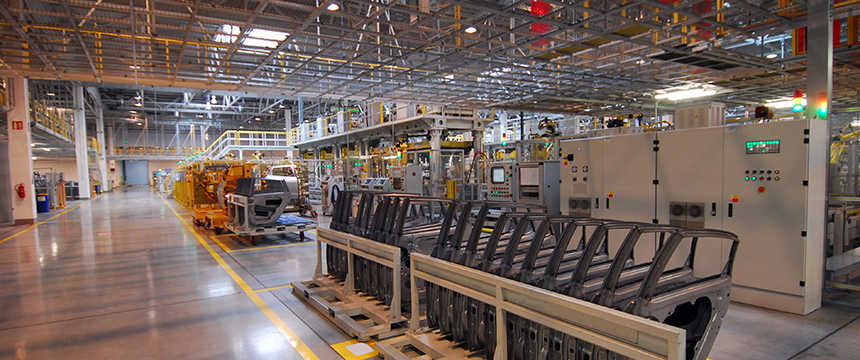
Disruption in the automotive industry seems a near-constant force these days. The automotive supply chain continues to suffer hangover challenges from the pandemic (including raw materials shortages and increased labor costs), reduced volumes, stops and starts in OEM production orders and rising interest rates. Despite this, carmakers continue to record rising profits. These factors impact automotive suppliers in particular as many struggle with reduced margins, with some even being driven to file for Chapter 11 bankruptcy protection. This article will help you understand the key disruptors manufacturers face in the near term, and provide practical tips for surviving (or even thriving) in the face of what Foley’s automotive attorneys see coming down the road.
1. More automotive suppliers will suffer financial distress, but these will create possible opportunities for growth through acquisition.
Lenders who previously provided extensions of credit and forbearance on defaults are increasingly asserting their rights and remedies in the case of new or ongoing defaults by financially distressed automotive suppliers. Variable interest rate facilities have become more burdensome, and it is significantly more difficult for companies to refinance their way out of a loan maturity or cash flow problem. In addition, due to the various financial pressures they face, the automotive industry is experiencing an uptick in suppliers that are considering or have decided to liquidate. Meanwhile, the OEMs project increased sales of vehicles to catch up with pent up demand, and thus production capacity in many parts of the automotive supply chain continues to be highly sought after.
The cash flow, credit and decreased profitability issues that borrower auto supplier companies face may result in opportunities to purchase them (or their lenders’ debt) at depressed valuations. While these deals may appear to be hard to come by, shrewd investors will be well served by considering both out-of-court and bankruptcy acquisitions of the distressed companies under pressure due to the current environment. Legal strategies and tactics exist to structure and execute these transactions to reduce risks that may otherwise exist for both the seller (and its management) and the buyer. Below is an overview of the fundamental strategies of effecting acquisitions outside of a court process, and in bankruptcy, with some key pros and cons.
Out-of-Court Acquisition
- Often structured like a normal asset deal.
- Due diligence is even more critical to understand and, where possible, avoid and creatively address, potential liabilities.
- Specify assumed liabilities and excluded liabilities.
- Include indemnification and escrow where possible (but seller might not be able to perform under indemnification).
- Negotiations with creditor constituencies can reduce exposure.
Pros:
- Fast, no court approvals required.
- Less expensive than a court process.
- Buyer can sometimes achieve more control/certainty and purchase protections than in a court process.
- Can obtain traditional M&A protections (e.g., escrow, rep and warranty insurance, indemnity).
- Typically does not require an auction with competitive bidding.
- Potentially easy on customer/supplier relationships (subject to contract terms).
Cons:
- Cannot “cherry pick” contracts as easily as in bankruptcy.
- Cannot force support from and bind non-consenting creditors (e.g., lenders).
- Risk of possible successor liability (vs “free and clear” sale in bankruptcy).
- Need shareholder consent.
- Fraudulent transfer risk where seller does not receive reasonably equivalent/fair value while insolvent, but consider these protections:
- Arm’s-length sale process with consents of key parties.
- Valuation opinion.
- Structure through a friendly foreclosure/Article 9 sale.
Bankruptcy 363 Sale
- Buyers often seek to avoid possible successor liability and other risks and require the sale to occur in a Chapter 11 to maximize buyer protections/rights.
- Section 363 of the Bankruptcy Code permits a debtor to sell substantially all of its assets if supported by reasonable business judgment, free and clear of all liens, claims, and encumbrances.
- Section 365 of the Bankruptcy Code permits a debtor to assume and assign, or reject, certain contracts and unexpired leases notwithstanding restrictions on assignment in such contracts.
- Upon a bankruptcy filing, the “automatic stay” arises and protects the seller’s assets from creditor collection efforts and contract terminations to enable a transaction to occur.
Pros:
- Court approved sale is “free and clear” of liabilities and balance sheet is clean.
- Shareholder approval not required.
- Eliminates fraudulent transfer risk.
- Enhanced successor liability protection.
- Contracts can be “cherry picked” and bad ones left behind, regardless of consent.
- Fast (sales can be approved within 30-60 days after a bankruptcy filing).
- Closing likely regardless of objecting creditors.
- Buyer can achieve “stalking horse” advantages: enhanced information, bid protections to protect itself and enhance purchase prospects (e.g., breakup fee and expense reimbursement, and bid increased by same), minimum bid increments and tight timeline for the sale.
- Tactic: If buyer owns secured debt – it can credit bid for increased control.
Cons:
- Sale will be to the “highest and best bid”; an auction is generally required and, notwithstanding stalking horse advantages, marketing process may yield an alternative winning bidder.
- Secured lender can credit bid its debt to set the floor.
- More expensive than an out-of-court acquisition.
- Unsecured Creditor Committee appointed in Chapter 11 may delay sale and seek to extract more value.
- Purchase is “as is” – diminished escrow/no indemnity.
2. An increase in financially distressed automotive suppliers will create threats to continuity of supply and threats to payment from customers.
The perfect storm of extraordinary factors creating conditions for financial distress throughout the automotive supply chain increases risk that some companies will breach, or threaten to breach, their contracts to supply goods or services, or to pay for the same. Moreover, some suppliers will be disrupted by the transition from internal combustion engine (ICE) vehicles to electric vehicles. Not all of these suppliers will have the financial strength to survive in this environment. And yet some of these suppliers may own technology that is valuable for more healthy, well-funded enterprises to opportunistically acquire or license for future use.
From a financially challenged supplier perspective, there are possible opportunities for cost recovery. While costs continue to rise, suppliers who seek cost recovery from their customers and who support their request with transparent and thorough data are more likely to achieve support from their customers. This can be in the form of increased prices, lump sum payments, resolution of commercial disputes and issues, or more profitable go-forward business. These negotiations can solidify the future of an otherwise financially distressed supplier, and actually strengthen long-term relationships within the supply chain to maximize value. Moreover, if the suppliers are in the electric and autonomous vehicle space, federal grants to support this newer portion of the industry are increasingly in play, such as those awarded by the Department of Energy in 2023 to support the manufacture of batteries for electric vehicles in the U.S.
Beyond cost recovery or grants for suppliers, critical strategies exist to mitigate supply chain risks and bolster the likelihood that distressed suppliers will continue to perform their obligations to your company and distressed customers will continue to pay your company for goods or services. For a detailed explanation of such strategies, click here.
Foley’s automotive attorneys who focus on financially distressed suppliers can help you decrease risks, and maximize opportunities in a challenging market.

